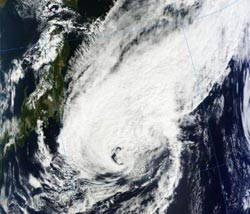NASA sees extra-large, now extra-tropical storm Prapiroon fading

The MODIS instrument aboard NASA's Terra satellite captured this visible image of Extra-tropical Storm Prapiroon on Oct. 19 at 01:15 UTC (Oct. 18, 9:15 p.m. EDT), about 270 nautical miles southeast of Tokyo, Japan and moving away.<br><br>Credit: NASA Goddard MODIS Rapid Response<br>
The Moderate Resolution Imaging Spectroradiometer (MODIS) instrument aboard NASA's Terra satellite captured a visible image of Extra-tropical Storm Prapiroon on Oct. 19 at 01:15 UTC (Oct. 18, 9:15 p.m. EDT).
The storm appeared on the MODIS image to be as large as the main island of Japan and the strongest thunderstorms and heaviest rainfall appeared north of the center of circulation over the open waters of the western North Pacific Ocean.
At 0300 UTC on Oct. 19 (11 p.m. EDT on Oct. 18), Prapiroon's maximum sustained winds were near 45 knots (51.7 mph/81.3 kph). It was centered about 270 nautical miles (310.7 miles/500 km) southeast of Tokyo, Japan, near 31.9 North latitude and 142.6 East longitude. It was moving away from Japan and headed east-northeast at 27 knots (31 mph/50 kph).
On Oct. 19, Prapiroon marked its twelfth day of life. It was born as Tropical Depression 22W on Oct. 7. On Monday, Oct. 8, the twenty-second tropical cyclone had organized and strengthened into Tropical storm Prapiroon and later became a typhoon. Now, as an extra-tropical cyclone, Prapiroon is expected to fade over the next couple of days over open waters.
Media Contact
More Information:
http://www.nasa.govAll latest news from the category: Earth Sciences
Earth Sciences (also referred to as Geosciences), which deals with basic issues surrounding our planet, plays a vital role in the area of energy and raw materials supply.
Earth Sciences comprises subjects such as geology, geography, geological informatics, paleontology, mineralogy, petrography, crystallography, geophysics, geodesy, glaciology, cartography, photogrammetry, meteorology and seismology, early-warning systems, earthquake research and polar research.
Newest articles

Recovering phosphorus from sewage sludge ash
Chemical and heat treatment of sewage sludge can recover phosphorus in a process that could help address the problem of diminishing supplies of phosphorus ores. Valuable supplies of phosphorus could…

Efficient, sustainable and cost-effective hybrid energy storage system for modern power grids
EU project HyFlow: Over three years of research, the consortium of the EU project HyFlow has successfully developed a highly efficient, sustainable, and cost-effective hybrid energy storage system (HESS) that…

After 25 years, researchers uncover genetic cause of rare neurological disease
Some families call it a trial of faith. Others just call it a curse. The progressive neurological disease known as spinocerebellar ataxia 4 (SCA4) is a rare condition, but its…





















